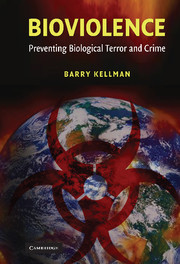Book contents
- Frontmatter
- Contents
- Prologue
- Foreword, by Ronald K. Noble, Interpol Secretary General
- Acknowledgments
- Introduction
- PART I THE BIOVIOLENCE CONDITION AND HOW IT CAME TO BE
- PART II THE GLOBAL STRATEGY FOR PREVENTING BIOVIOLENCE
- 4 Strategic Foundations
- 5 Complication: What Law Enforcers Should Stop
- 6 Improving Resistance through Science
- 7 Public Health Preparedness
- 8 International Nonproliferation
- 9 The Challenge of Global Governance
- Conclusion
- Notes
- Bibliography
- Index
9 - The Challenge of Global Governance
Published online by Cambridge University Press: 27 July 2009
- Frontmatter
- Contents
- Prologue
- Foreword, by Ronald K. Noble, Interpol Secretary General
- Acknowledgments
- Introduction
- PART I THE BIOVIOLENCE CONDITION AND HOW IT CAME TO BE
- PART II THE GLOBAL STRATEGY FOR PREVENTING BIOVIOLENCE
- 4 Strategic Foundations
- 5 Complication: What Law Enforcers Should Stop
- 6 Improving Resistance through Science
- 7 Public Health Preparedness
- 8 International Nonproliferation
- 9 The Challenge of Global Governance
- Conclusion
- Notes
- Bibliography
- Index
Summary
Throughout this book is a persistent plea to establish a global governance architecture for preventing bioviolence – its absence induces policy inertia. It is difficult to envision how prevention policies can advance without some entity to make decisions, supervise their implementation, and monitor compliance. Identifying who or what should undertake those responsibilities is a crucial challenge for international law.
To make this challenge manageable, a useful admonition is that form follows mission.
GOVERNANCE MISSION: THE GLOBAL COVENANT
Nearly one million children under the age of five died last month, mostly in developing countries. Most of these deaths were due to malnutrition or diseases that are readily preventable. Next month, another million children will die. The month after … In some developing countries, average life expectancy is sinking below forty years; in developed countries it is rising above eighty.
In contrast to these appalling statistics is the undeniable fact that preventing bioviolence is expensive. States must enact new regulatory laws, equip and train police, implement and enforce controls on pathogens and laboratories, facilitate development of and access to vaccines, and empower the domestic penal system to detect and prosecute behavior designed to cause catastrophic harm. Large quantities of information must be gathered and analyzed by trained officials. First responders and public health networks need to be prepared. All these systems must be linked to counterparts in other States and to relevant international organizations.
- Type
- Chapter
- Information
- BioviolencePreventing Biological Terror and Crime, pp. 222 - 241Publisher: Cambridge University PressPrint publication year: 2007

